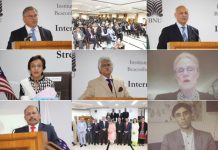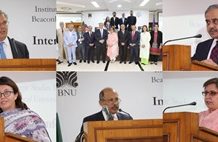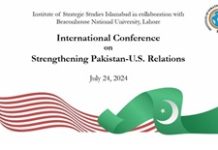The socio-religious dimension
The reason for my harping on the pressing need for improvement of Pakistan’s relations with Iran goes beyond political and economic interests of our country. It has to do, instead, with something basic to Pakistan’s persona: the socio-religious identity of the nation.
It is in any case only recently that after a longish period of unease, if not estrangement, between Islamabad and Tehran, the bilateral ties have returned to normalcy. That, in my view, has been made possible with Pakistan’s regaining its sovereign decision-making authority since the reported death of Osama bin Laden.
I have written it elsewhere earlier, but given the importance of the subject, it can stand a reiteration. What is required here is for Pakistan to revive the kind of fraternity that existed between the two nations more than three decades ago.
That, in my view, is of far greater import for both states than the adjustments and at times even drastic changes – as was the case for Pakistan post-9/11 – that the changing geopolitical and geostrategic environment may necessitate for all states with the passage of time.
At any rate, getting back to the narrative of the recent past, the rupture in both the political and the socio-religious affinity occurred as a result of two watershed developments in quick succession 34 years ago. The first of course was the success of the Islamic Revolution in Iran in 1979, and then came the Soviet Occupation of Afghanistan before the year was to come to an end.
No aspect of collective human life can be seen in isolation of the political currents and influences it is subjected to at any given time. It would, therefore, be naïve to approach the given context of the socio-political linkages between the inhabitants of the Indus Valley and their neighbours beyond the Suleiman Range to the west in Persia. With reference to the contemporary era, we shall take up the political dimension of the question in a while.
Meanwhile, the bedrock of the social, religious, cultural and linguistic bond that existed historically between the two lands needs to be outlined in brief.
A tragedy in the case of Pakistan has been the fabricated history that successive rulers have found it expedient to adopt and disseminate as the officially certified truth to be propagated and taught in educational institutions of the country. What could, for instance, be more deleterious than to inculcate in an incipient nation the patent fallacy that its faith, its belief system was changed to Islam so many centuries ago by invading armies from Arabia and Central Asia?
Conversion here, in the religious sense, that is, is anything but, say, the transformation of a solid substance like ice into its liquid form of water through exposure to heat. It’s a matter of the heart, the soul, instead. The human body, as also an individual’s will, may well be forced into submission but that is not conversion of the kind that a person truly believes in.
Let us be absolutely clear on this count: nobody in the Indus Valley – nor anywhere else on the planet for that matter – has ever been or can be converted from one belief system to another without the total acceptance deep within of the veracity of the message as against whatever the relevant person may earlier have adhered to.
Thus, in the case of the inhabitants of the Indus Valley as well, the conversion to Islam took place mainly under the inspiration provided by Muslim mystics and sages who travelled to this part of the world from Persia. The two neighbouring lands’ commonalities – ranging from factors of history, geographical location, culture, art, language, literature, to the belief system – are all well documented and need not be noted here. It may not be an overstatement to assert that Pakistan and Iran have, in historical terms starting with the advent of Islam in the seventh century, had a traditional linkage.
Most importantly in contemporary geostrategic terms that have since 9/11 come to be pivoted on mindless violence under misplaced religious inspiration – that the sole superpower has no less unthinkingly proclaimed an unending War on Terror – it is the quintessentially pacifist message of Islam that had transformed the minds and souls of the inhabitants of the Indus Valley in the first place.
That is where Iran comes in insofar as those professing Islam in the Indus Valley were concerned. For the uninitiated, Pakistan post-bifurcation from its eastern wing in 1971, is nothing but the Indus Valley, divested of course of a substantive, some would say strategically crucial, stretches that fell to India at the time of and in the manner in which the subcontinent was partitioned by the departing British colonial power in 1947.
The so-called ‘ideology’ of Pakistan is a subject of intensive debate and discussion in this country. One would in a word describe it a painful attempt at soul-searching by the people of Pakistan, perturbed as they are at the country’s slide to religious divide and intolerance. Of prime importance as these fundamental questions of nationalism are, it should, in the given context, suffice to merely state that the inherently Persian socio-cultural and religious moorings of the inhabitants of the parts of the Indus Valley that constituted (West) Pakistan were mutilated at the time of the country’s formation.
Coming to more recent times, as already noted, 1979 proved to be a watershed year. It witnessed the success of the Iranian Islamic Revolution in the first place and came to a close with Soviet troops in occupation of Afghanistan. Pakistan found itself bang in the middle of these epochal developments. Any established order is less than enthusiastic at the prospect of its being rooted out. The case was no different for Pakistan at that stage, lashed as it was by the diametrically opposing tides of communist and Islamic orders.
This is a thread that requires further dilation. So watch this space next week.
Views expressed are of the author and do not necessarily reflect the views of ISS or of the Government of Pakistan.













